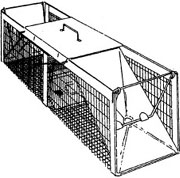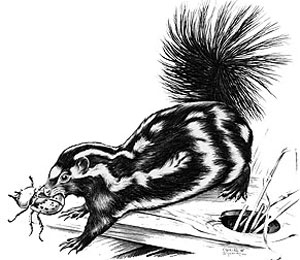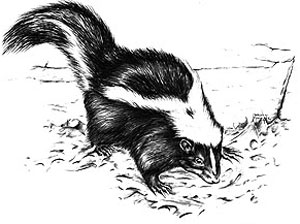Two species of skunks are found in Missouri. The eastern spotted skunk, Spilogale putorius, has white splotches on its back and sides. It is now rarely found in the state and is fully protected as a threatened species under state regulations. Also known as the civit cat, adult spotted skunks are typically 14 to 22 inches long and weigh from 3/4 to 2-3/4 pounds.
The striped skunk, Mephitis mephitis, is more common. Its color pattern is typically characterized by two prominent white stripes down the back in a coat of jet-black fur. The amount of white on the back varies tremendously, from just a patch on the head to stripes covering the entire back.
New research findings in the fossil record obtained from evolutionary biologists suggests that skunks are evolutionarily distinct enough from other mustelids (as they were historically classified) to warrant a separate family, the Mephitidae. Because many of the habits of the eastern spotted skunk and the striped skunk are similar, the following discussion of biology and natural history applies to both species.
Biology and habits
Skunks can be found in a variety of habitats throughout Missouri. Favorite areas include rolling hayfields, fencerows, brushland, woodland edges, weedy fields, rocky outcrops, wooded ravines and drainage ditches. Skunks live in underground dens that may be found in vacant buildings, under house porches, culverts, brush piles, tree stumps, lumber piles or in abandoned fox or woodchuck burrows.
Dens are lined with leaves, hay or grasses. Skunks use a variety of dens for loafing during the day, for giving birth and raising young and for periods of inactivity during the winter. Skunks are nocturnal, becoming active from sunset to slightly after sunrise. During the day, they usually sleep in the den. During the winter months, skunks may remain inactive in the den for a period of days or weeks. Skunks do not hibernate but become inactive during cold weather, relying on stored body fat to get them through the winter. Several skunks may share the same den during the winter to conserve body heat.
Female skunks typically do not travel great distances, whereas males may travel up to four to five miles a night during the breeding season. Skunk home ranges normally vary from 1 to 1-1/2 miles in diameter.
During the breeding season, males move slowly, become active during the day and are reluctant to flee when endangered. This is the time when skunks are often struck by cars.
In Missouri the breeding season for skunks begins in late January when males begin searching for females near winter dens. Skunks mate in February, and the young are born in May or June. Usually five to nine kits are born in a litter, but there can be as many as 18 or as few as two. Young are weaned when they are about two months old. Families break up in August and September when the young leave to find their own homes.
Skunks are opportunistic feeders, feeding on both plant and animal material. Favorite skunk foods include grasshoppers, crickets, beetles, wasps, cutworms and other insect larvae. When insects are not available, skunks will eat mice, rats, shrews, moles, chipmunks and other small mammals. They will also eat amphibians, reptiles, fish, fruits and garbage. They will occasionally feed on poultry and the eggs of ground-nesting birds.
Skunk damage assessment
Skunks become a problem when they dig under foundations; take up residence under a house, porch or building; dig in lawns, golf courses and gardens for insect larvae or roots; disturb refuse and garbage cans or kill and eat poultry eggs or fowl. Skunk diggings appear as 3- to 4-inch cone-shaped holes or patches of upturned earth. Be cautious, as many other animals, including domestic dogs, also dig in lawns. Skunks can also damage beehives as they feed on adult and larval bees.
Most skunk problems are related to the animal's ability to discharge an obnoxious odor when provoked. The scent, produced by two internal glands located at the base of the tail, is usually released for self-defense. Before spraying the thick, volatile, oily, sulfur-containing compound, skunks usually stamp their front feed rapidly, and growl or hiss.
Skunks generally walk a short distance on their front feet and raise their tail as a warning before releasing any scent. The fluid is released in a fine spray directed accurately up to 10 feet and less accurately to 20 feet. Skunks can discharge the spray several times within a short period. The fluid is painful if it gets in a person's eyes and may cause temporary blindness for up to 15 minutes.
Rabies
Skunks are highly susceptible to rabies. Because they can become locally abundant and transmit rabies to other mammals, skunks cause concern for human health and livestock safety. Rabies is a serious viral disease that infects many types of warm-blooded animals. It is generally spread by direct contact with an infected animal, usually by biting.
When a skunk becomes infected with the rabies virus, it may go unnoticed for a period of time. Symptoms may not appear for weeks or months. During this time, the infected animal may transmit the virus to other animals it contacts. In the final stages of the disease, skunks may lose their fear of humans, seem tame or listless, show signs of excessive salivation, become unusually aggressive or nervous, or wander about during the daytime.
Skunks are usually docile, slow-moving animals, and their main period of activity is from sunset to sunrise. If you notice a skunk acting strangely (aggressive or nervous, wandering in the daytime, or tame and listless), do not approach it. Parents should warn children never to approach or pet a skunk or any other wild animal. If you live in an area where there is a large skunk population, all pet dogs and cats and important livestock should be vaccinated for rabies.
Do not keep skunks or other wild animals for pets because they cannot be effectively immunized against the disease. Furthermore, they may have contacted the disease at an early age and be infected, yet fail to exhibit symptoms for some time.
If you are bitten by a skunk or other wild animal, capture and cage the animal if at all possible. Do not shoot the skunk in the head, because the health department will require the head to determine if the animal was rabid. After you have been bitten, scrub the wound with warm soapy water and seek medical attention immediately.
Submit the head of the animal to the state public health department for testing. Your local public health authorities, physician or veterinarian can provide additional information on rabies. Animals suspected of being rabid should be submitted for diagnosis to your public health officials.
Skunk odor control
People often find the smell of skunk musk nauseating. Skunk odor can be effectively reduced by using a variety of commercial and home remedies. Neutroleum alpha is a commercial deodorant that effectively masks skunk musk. Ecosorb, a plant-based odor neutralizer is also available.You can purchase either product by contacting the U.S. Department of Agriculture, Animal and Plant Health Inspection Service, Wildlife Services at 573-449-3033.
These compounds can also be used to bathe pets or humans or to scrub basements, floors, garages, walls, etc. They can also be sprayed in a room or onto contaminated soil from an aerosol sprayer. Other commercial-strength deodorants available from janitorial supply houses may also be effective.
Home remedies that may help to reduce the intensity of the smell include tomato juice, vinegar and diluted chlorine bleach or ammonia. Be careful when using any of these materials because they may cause color changes on certain materials, and they may be caustic to humans and pets. Note cautions on product labels before using them.
Prevention
The best long-term solution to managing skunk problems is to prevent them from happening. Homeowners should take preventive measures to keep skunks from becoming abundant in urban areas. Lawns and farmsteads that are kept clean are less attractive to skunks. Remove all debris from the yard where skunks could find shelter or food (insects or small rodents). These include old boards lying on the ground, rocks, junk and stacked lumber or trash piles.
Clean up and destroy dens and remove food sources by taking away exposed pet food, putting strewn garbage in sealed containers and carrying off woodpiles harboring mice and rats. Many farmsteads have grain storage areas that attract mice and rats and possibly skunks in search of an easy meal. Unless the rodent problem is solved, this source of food will create a continual skunk problem. A good integrated rodent control program will eliminate this attraction. To summarize, modify the environment by removing sources of shelter and situations that create rodent or insect problems.
Most skunks can be prevented from digging and denning under foundations, porches or buildings by sealing all openings. Use sturdy wire mesh hardware cloth (1/4- or 1/2-inch mesh) to tightly seal holes in foundations, under porches, vents near ground level or other areas where a skunk could enter. The wire mesh should be buried 12 to 18 inches underground if the skunk could gain access by digging. The bottom six inches should be bent outward in an "L" shape to prevent skunks from digging under it.
Aboveground fences can be constructed of three-foot wide, 1-inch poultry netting with the bottom 12 inches buried underground. Fencing will also keep skunks out of landscaped areas and gardens.
If you know skunks are living under a house, porch, barn or other structure, you can exclude them from reentering. Wait until after dark when the skunk has left to seek food. Examine the dirt at the den entrance. Fresh tracks indicate the skunk has left for the evening. If you do not see tracks easily, sprinkle fine sand or flour at the entrance as a visual aid.
If you think more than one skunk is living under the building, attach a piece of 1/2-inch hardware cloth to the opening. This wire should be larger than the entire entrance and should be hinged at the top but loose on the other three sides. This simple device will allow skunks to push open the gate and leave, but not reenter. Once the skunks are gone, seal the entrance and any other opening completely. Be sure to follow the instructions on exclusion mentioned previously.
Control
There are no chemical repellents or toxicants (poisons) registered for controlling skunks in Missouri. Other than habitat modification and exclusion mentioned above, the only methods available for controlling skunks are trapping and shooting.
Skunks are considered furbearing animals and receive protection under Missouri law. However, if a skunk is damaging your property, you can legally take action to prevent further damage.
 Trapping is the preferred and most often recommended way of removing and disposing of problem skunks. A variety of live traps are available from hardware, agricultural supply and feed stores for catching skunks Live traps should be about 12 x 12 x 36 inches in size.
Trapping is the preferred and most often recommended way of removing and disposing of problem skunks. A variety of live traps are available from hardware, agricultural supply and feed stores for catching skunks Live traps should be about 12 x 12 x 36 inches in size.
 Live traps are the preferred way of capturing and disposing of problem skunks.
Live traps are the preferred way of capturing and disposing of problem skunks.
Bait the trap with canned or fresh fish, fish-flavored cat food, sardines, chicken entrails or peanut butter. If you know the location of the entrance to the den, place the trap directly in front of it so that the skunk will enter the trap as it leaves the den. Other locations to set traps are along foundations and near trails or fence openings. In urban areas, it is not unusual to catch house cats instead of skunks. Mayonnaise, peanut butter, dried fruit, honey, or molasses on bread attract skunks and not house cats.
Skunks are easy to catch and can be transported without releasing their scent if they are moved carefully. Before setting the trap, cover it with heavy burlap or a canvas tarp. This creates a dark, secure environment in which the skunk will be less likely to release its scent. Be sure to leave each end open.Gently pick up the covered trap and place it in the back of a pickup truck for transportation. You must work quietly and slowly and avoid sudden, jarring movements or loud noises.
Because of the potential for spreading rabies, skunks should not be released back into the environment but should be humanely dsposed of. When a skunk is infected with rabies, the disease may not be apparent and symptoms may not appear for weeks or months. A healthy-looking skunk may actually be diseased and may infect other wild animals it contacts. In this case, you will not be helping other animals by transporting the skunk to a "new home."
Remember, skunks are an important part of the natural world. They are highly beneficial to farmers, gardeners and landowners because they eat agricultural and garden pests. The best approach in managing skunk problems, where possible, is to leave the animals alone.
For more information on controlling nuisance skunks, contact your MU Extension center.

 Spotted skunk.
Spotted skunk.
 Striped skunk.
Striped skunk.